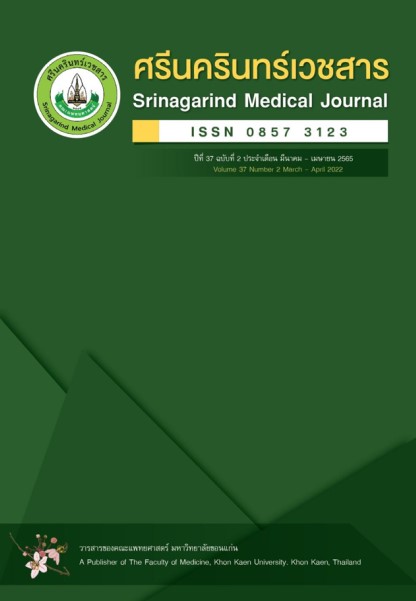Attitudes and Perceptions of Future Blood Donors During Covid-19 Pandemic
Keywords:
blood donation, COVID-19, attitudesAbstract
Background and Objectives: The aim of this study was to investigate the awareness, attitudes and perceptions on the crisis of blood scarcity during the Covid-19 pandemic.
Methods: A cross-sectional descriptive study was conducted in the secondary school Thai students. They participated the study by responding the questionnaires via on-line application that assessed the motivation for the intention in blood donation. In addition, the questionnaires also included other questions relating to types of public communication regarding to the process of blood donation. Descriptive statistics of frequencies, percentages, and standard deviation were calculated and presented.
Results: A total of 620 secondary school Thai students were included in this study with male to female ratio of 1:1.63. More than 70% of all participants had realized that there is crisis of blood shortage during Covid-19 pandemic; however, only 26.84% of female and 16.67% of male had an intention to donate blood. The most favorable channel for communication to receive news and information in participants was social media platform. This was found in 46.32% of female and 39.17% of male.
Conclusions: The secondary school students who are eligible blood donors in the future should be essentially concerned to be educated correctly in blood donation. Importantly, Thai male students, who had low intention of donating blood, should be intensively focused and encourage them to voluntarily donate blood. Additionally, the main method used for communication in Thai students should be social media platform while public communication presented in school can be a supplementary channel.
References
Kaur P, Basu S, Kaur G, Kaur R. Transfusion protocol in trauma. J Emerg Trauma Shock 2011;4(1):103-108.
Kogutt BK, Vaught AJ. Postpartum hemorrhage: Blood product management and massive transfusion. Semin Perinatol 2019;43:44-50.
LeBlanc TW, Egan PC, Olszewski AJ. Transfusion dependence, use of hospice services, and quality of end-of-life care in leukemia. Blood 2018;132:717-26.
Shah FT, Sayani F, Trompeter S, Drasar E, Piga A. Challenges of blood transfusions in β-thalassemia. Blood Rev 2019;37:100588.
World Health Organization. Blood safety and availability [Internet]. 2020 [cited Dec 31, 2021]. Available from: https://www.who.int/news-room/fact-sheets/detail/blood-safety-and-availability
Thai Red Cross Society. Impact of COVID-19 Pandemic on Blood Donation [Internet]. 2021 [cited Jun 26, 2021]. Available from: https://english.redcross.or.th/
Cochran WG. Sampling Technique. 2nd Edition, John Wiley and Sons Inc., New York, 1963.
AnongsriSimsiri1,KannikaRuangdej2andPaiboonChaosuansreecharoen.FactorsInfluencingIntentiontoBloodDonationamongPeopleofNarathiwat. J HematolTransfus Med 2012;22:175-87.
Saithong Wongkham.Factor Affecting Blood Donation of Donors at Blood Bank Unit, Hua Hin Hospital . Academic Services Journal Prince of Songkla University 2015;26 (2):85-94. พฤษภาคม-สิงหาคม 2558
Unchalee Pochailert. Factors influencing public consciousness about blood donation in Thailand A thesis submitted in partial fulfillment of the requirements for the degree of master of arts program in mass communication faculty of journalism and mass communication Thammasat University academic year 2015 copyright of thammasat university. 2015.
Alanzi T, Alsaeed B. Use of Social Media in the Blood Donation Process in Saudi Arabia. J Blood Med 2019;10:417-23.
Rael CT, Pierre D, Frye V, Kessler D, Duffy L, Malos N, et al. Evaluating blood donor experiences and barriers/facilitators to blood donation in the United States using YouTube video content. Transfusion 2021;61(9):2650-7.
Tripathi PP, Kumawat V, Patidar GK. Donor's Perspectives on Blood Donation During Covid-19 Pandemic. Indian J Hematol Blood Transfus. 2021;1-10. doi: 10.1007/s12288-021-01504-y.
Yahia AIO. Management of blood supply and demand during the COVID-19 pandemic in King Abdullah Hospital, Bisha, Saudi Arabia. Transfus Apher Sci 2020; 59(5): 102836.
Kandasamy D, Shastry S, Chenna D, Mohan G. COVID-19 pandemic and blood transfusion services: The impact, response and preparedness experience of a tertiary care Blood Center in southern Karnataka, India. Hematol Transfus Cell Ther 2021; 44(1):17-25. doi:10.1016/j.htct.2021.09.019.
Barjas-Castro MdL, Baumgartner JE, Sales LNM, Santos RA, Pereira FB, Castro V. Blood supply strategies facing a reference blood centre in Brazil during the COVID-19 pandemic. Int Soci Blood Transfusion, ISBT Sci Series 2020;15(4):374-7.
Sahu KK, Raturi M, Siddiqui AD, Cerny J. "Because Every Drop Counts": Blood donation during the COVID-19 Pandemic. Transfus Clin Biol 2020;27(3):105-8.
Downloads
Published
How to Cite
Issue
Section
License
Copyright (c) 2022 Srinagarind Medical Journal

This work is licensed under a Creative Commons Attribution-NonCommercial-NoDerivatives 4.0 International License.



